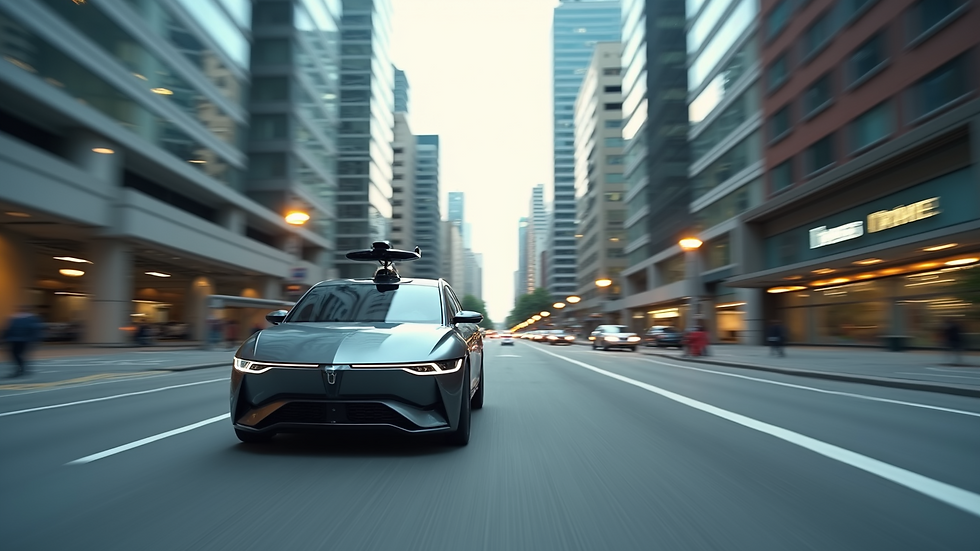Transformative Innovations in Transportation Technology
- Jaycee
- Jul 24
- 4 min read
The landscape of transportation is undergoing a seismic shift, driven by innovative technologies that promise to redefine how we move people and goods. From the rise of electric vehicles to advancements in autonomous driving, we are witnessing a revolution in the way we think about and utilize transportation. Today, we will explore the transformative innovations currently shaping the future of transportation technology.
Future of Transportation Technology
As we delve into this topic, it's essential to recognize that these innovations are not just about improving efficiency or reducing costs. They're also about enhancing user experience, increasing safety, and promoting sustainability. For example, electric vehicles (EVs) are now more accessible than ever, thanks to decreased production costs and expanded charging infrastructure. According to the International Energy Agency (IEA), the global stock of electric cars surpassed 10 million in 2020, a significant milestone that signals growing acceptance and adoption.
Adopting new transportation technologies also allows cities to rethink their infrastructure. Innovations such as smart traffic management systems are designed to optimize flow and reduce congestion, contributing to a smoother, more efficient urban experience for commuters.

Autonomous Vehicles: A New Era on the Road
One of the most talked-about advancements in transportation technology is the development of autonomous vehicles (AVs). Self-driving cars have the potential to transform everything from personal transportation to logistics and freight delivery. Companies like Waymo, Tesla, and Uber are at the forefront of this innovation, conducting tests in various environments to refine their technologies.
The promise of AVs includes not only convenience but also safety. According to the National Highway Traffic Safety Administration (NHTSA), the majority of vehicle crashes result from human error, which could be drastically reduced with the introduction of AVs. For instance, Tesla's full self-driving software has demonstrated significant improvements in safety during its pilot programs.
However, the transition will not be without challenges. Legal regulations, insurance liability, and public acceptance are significant hurdles that need to be addressed. Still, as technology advances, there will likely be more clarity, leading to a wider acceptance of autonomous vehicles.

What is the Latest Technology in Transportation?
The latest technology transforming the transportation sector includes not only electric and autonomous vehicles but also extensive advances in materials science and data analytics. Lightweight materials such as carbon fiber and advanced composites are increasingly used in manufacturing cleaner, more fuel-efficient vehicles. These materials not only reduce energy consumption but also enhance performance and safety.
On the technological front, the rise of big data and artificial intelligence (AI) in transportation improves everything from traffic management to predictive maintenance. For example, cities are incorporating data analytics to monitor traffic patterns and optimize signal timings, thereby reducing congestion. Moreover, AI algorithms can predict maintenance needs for vehicles based on usage patterns, preventing breakdowns and ensuring increased uptime.
Another area ripe for innovation is urban air mobility (UAM)—the concept of using electric vertical takeoff and landing (eVTOL) aircraft to transport passengers across cities. Companies like Joby Aviation and Volocopter are developing these aircraft to alleviate ground traffic congestion, allowing for faster commutes and more efficient logistics.

Sustainable Transportation Solutions
With growing concerns over climate change and environmental degradation, the shift toward sustainable transportation is more critical than ever. Innovations such as shared mobility services, bike-sharing programs, and electric mass transit options are being embraced by cities worldwide. For instance, the rise of bike-sharing startups like Lime and Bird has encouraged more people to opt for two wheels over four, reducing their carbon footprints in the process.
Moreover, the incorporation of renewable energy sources such as solar and wind power into public transportation systems further emphasizes the trend towards sustainability. Cities are investing in electric buses and trams, which not only reduce greenhouse gas emissions but also lower operating costs in the long run. According to a report by the International Council on Clean Transportation (ICCT), transitioning to electric buses could lead to significant reductions in lifecycle emissions.
A successful example of such initiatives can be seen in cities like Amsterdam, which has dedicated substantial resources to promoting cycling and public transport systems, demonstrating that sustainable solutions can coexist with urban development.
The Future of Infrastructure
As transportation technology evolves, so too must our infrastructure. Traditional road systems, railways, and airports are often ill-equipped to handle the innovations coming down the pipeline. Smart infrastructure—equipped with sensors, connectivity, and data processing capabilities—is becoming increasingly important for future-proofing our transportation networks.
For instance, smart highways featuring embedded sensors can communicate with autonomous vehicles to improve safety and efficiency. Similarly, airports are incorporating advanced technologies such as biometrics and automated baggage handling to enhance the customer experience while also streamlining processes.
As municipalities invest in upgrading road networks, we will see a growing need for public-private partnerships to fund these transformative projects. Creative financing and collaborations will be essential for ensuring that public infrastructure can keep pace with technological developments.
Embracing the Change
With the rapid developments in transportation technology, it’s clear we are on the cusp of major changes. Stakeholders from governments to businesses and individuals must be prepared to adapt. This transition offers numerous opportunities, particularly for those willing to embrace emerging transportation technologies.
Educational institutions and training programs will play a critical role in preparing the workforce for the changes ahead. Upskilling workers to be proficient in newer technologies ensures they remain relevant in a rapidly changing job market. Additionally, advocating for policies that support research, development, and deployment of sustainable transportation options will be crucial.
The future of transportation technology presents us with the chance to create safer, more efficient, and more sustainable systems. By leveraging the innovations at our disposal and adapting to the changes coming our way, we can build a transportation ecosystem that serves all of society.






Comments